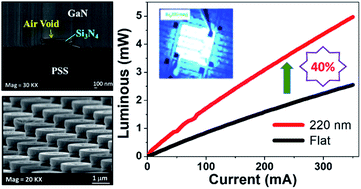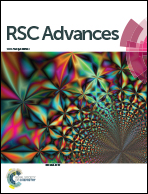Novel patterned sapphire substrates for enhancing the efficiency of GaN-based light-emitting diodes
Abstract
In this study, a novel patterned sapphire substrate (PSS) was used to obtain mesa-type light-emitting diodes (LED), which can efficiently reduce the threading dislocation densities. Silicon nitride (Si3N4) was used as a barrier to form the PSS, replacing the commonly used silicon dioxide (SiO2). The refractive index of Si3N4 is 2.02, which falls between those of sapphire (1.78) and GaN (2.4), so it can be used as a gradient refractive index (GRI) material, enhancing the light extraction efficiency (LEE) of light-emitting diodes. The simulation and experimental results obtained indicate that the LEE is enhanced compared with the conventional PSS-LED. After re-growing, we observed that an air void exists on the top of the textured Si3N4 layer due to GaN epitaxial lateral overgrowth (ELOG). Temperature-dependent PL was used to estimate the internal quantum efficiency (IQE) of the PSS-LED and that of the PSS-LED with the Si3N4 embedded air void (PSA-LED). The IQE of the PSA-LED is 4.56 times higher than that of the PSS-LED. Then, a TracePro optical simulation was used to prove that the air voids will affect the final luminous efficiency. The luminous efficiency of the four different structures considered is ranked as Si3N4 (PSN-LED) > PSA-LED > PSS-LED with SiO2 (PSO-LED) > PSS-LED. Finally, we fabricated LED devices with different thickness of the Si3N4 barrier. The device shows the best luminance–current–voltage (LIV) performance when the Si3N4 thickness is 220 nm.



 Please wait while we load your content...
Please wait while we load your content...